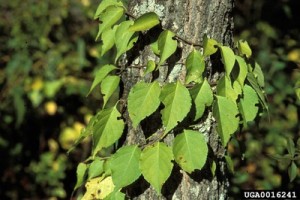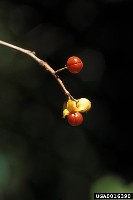Written by D.J. Moorhead and G.K. Douce for Forest Encyclopedia Network
Oriental bittersweet is a deciduous, climbing, woody vine that can grow to lengths of 60 ft (Miller 2003). The alternate, elliptical leaves are light green in color (Fig. 1). Small, inconspicuous, auxiliary flowers give way to round green fruit. The fruits ripen and split to reveal showy scarlet berries in winter (Fig. 2). The bark is dark gray to brown and smooth when young but flaking and becoming striated on older stems. It closely resembles American bittersweet (Celastrus scandens) but can be distinguished because American bittersweet has flowers and fruits in terminals rather than auxiliary along the stem (Miller 2003).
Characteristics of Oriental Bittersweet. Figure 2. (left) When the green fruit of Oriental bittersweet ripens it splits to reveal showy three-parted berries. Figure 3. (right) Young Oriental bittersweet vines have smooth, grayish bark. The vines will often wrap around themselves to gain stability.
Oriental bittersweet was introduced from China around 1860 as an ornamental (Swearingen et al. 2002). It is commonly found through the southern Appalachians in old house sites, fields, and road edges. Some shade tolerance allows it to also grow in open forests.
Oriental bittersweet’s prolific vine growth allows it to grow around trees and girdle them (Fig. 3). It also can completely cover other vegetation and shade, out-compete and kill even large trees. It can be dispersed widely and quickly due to the berries being eaten and spread by birds.
Oriental bittersweet has also been shown to hybridize with American bittersweet, potentially leading to a loss of genetic identity.
Adapted for eXtension.org by Thomas DeGomez, University of Arizona
References Cited
Miller, J.H. 2003. In: Nonnative invasive plants of southern forests: a field guide for identification and control. Asheville, NC: U.S.Department of Agriculture,Forest Service,Southern Research Station: 93p.
Swearingen, J., K. Reshetiloff, B. Slattery, and S. Zwicker. 2002. Plant Invaders of Mid-Atlantic Natural Areas. National Park Service and U.S. Fish & Wildlife Service. 82 p.
External Links
Nonnative Invasive Plants of Southern Forests-Oriental Bittersweet
Related to Oriental Bittersweet:
- Invasive Species and Biodiversity
- Invasive Forest Plants
- Invasive Species and Climate
- Diversity in the Forest Understory



